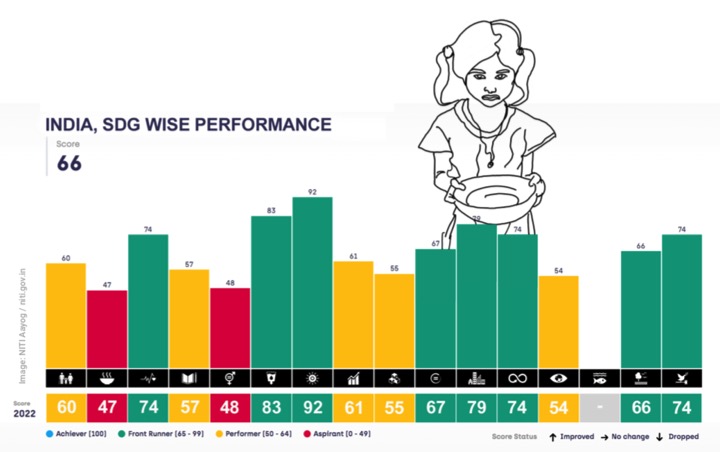A hungry girl child is the India’s poorest per- son. She suffers from hunger, inequality, and abuse, for no mistake of hers. Starting from one’s physical and mental disabilities to caste and illiteracy, there could be other relevant parameters of poverty, but a midway evaluation of the United Nations’ Sustainable Developmental Goals in India, done by NITI Aayog, highlights that these two goals, zero hunger and gender equality, have performed the least for the last few years; and there are less indications of them getting better. This aught to be a cause for worry for a country that, according to the address of Narendra Modi at the US Congress in June 2023, boasts of being the fifth largest economy in the world; and claiming to be the third soon.
According to a UNICEF study, globally girls have higher survival rates at birth, are more likely to be developmentally on track, and do better in preschool, but India is the only large country where more girls die than boys; and more girls are likely to drop out of school. Statutory laws brought some relief to women of the elite, but not to the poor. Poverty and gender inequality is a critical combination to combat and win against. An estimated 87 million women and girls are liv- ing in extreme poverty in India in 2020; with the pandemic, it is less likely that the numbers look any better now. Combine this with India ranked at 127 out of 146 countries in terms of gender parity according to the annual Gender Gap Report, 2023 of the World Economic Forum.
Tilted Development to Sustainable Development
Humans as a civilisation can’t but grow and evolve; but in what direction and at what cost is the concern. There have been many courses and efforts. Western liberal model of development, holding autonomy, rights and self-interest of the individual as the basis of all development, promoted rapid industrialisation, technological advancement, modernisation, and liberalisation of society, economy and polity. It leads to economic inequalities and concentration of wealth in the hands of the rich class of capitalists. It gives rise to a monopoly of the rich and exploitation of the poor.
Welfare model of development accepts and strongly advocates the role of state promoting the socio-economic welfare and common interests of the society. The assumption is that the welfare state protects all social, economic and political rights of all the people and in turn the people act in a socially responsible way. However, the welfare model did not succeed in securing the desired development: the bureaucracy proved to be inefficient and corrupt. Welfare goals were secured partially but with undesirable delays, and made the people utterly dependent upon the state.
Socialist/Marxist model of development takes on revolutionary means and a centralised system to attain progress and development. Though they placed full emphasis upon the social and economic rights and social justice they were found to be weak and unproductive; and began collapsing in 1980s and 90s.
Democratic-socialist model of development secures socialist goals by using democratic means. India and several other Third World countries adopted this model combined with welfare state structure. However, this model also proved to be inadequate due to bureaucratic inefficiency, corruption, and faulty planning priorities.
India’s Gandhian model of development, as opposed to the western materialistic model of development, gives primacy to moral and ethical view of socio-economic-political development. It is decentralised model of each village acting as a self-regulating and self-sufficient unit of development with truth and non-violence as the basis of every decision and action. It recommends avoiding machines that deprive humans of employment; and escape industrialisation that generates consumerism and profiteering. All development must ensure environmental health and human happiness.
Sustainable development, according to the Brundtland Report (1987) is ‘Development that meets the needs of present without compromising the ability of future generations to meet their own needs’. The critical global environ- mental problems are primarily the result of the enormous poverty of some regions and the non-sustainable patterns of consumption and production in other regions. Sustainable development is mindful of areas extending from viable population levels, gender justice, socio-economic justice to environmental protection.
What We Had, What We Needed, What Is Left, and What Is Wasted
The starting point of Sustainable development model is the instructive fact that natural resources are finite. For example, the UN Food and Agricultural Organisation has predicted that by 2025, 1.8 billion people are going to be living in areas or regions of absolute water scarcity. It is a naïve assumption that the planet on which we live will always provide the resources that we need. The planet and its recourses are not limitless and boundless by any stretch. Every year we consume twice the resources that our planet can replenish, which is referred to as ecological overshoot, meaning, human demand exceeds the regenerative capacity of a natural ecosystem.
In other words, humanity’s ecological foot- print exceeds what the planet can regenerate. The need of the hour is sustainable development. For any development to be enduringly sustain- able it requires to be inclusive in thinking and action, harness diversity of thought and imagination, and show a hell lot of intent.
Written as TOGETHER editorial.

Comments
Post a Comment